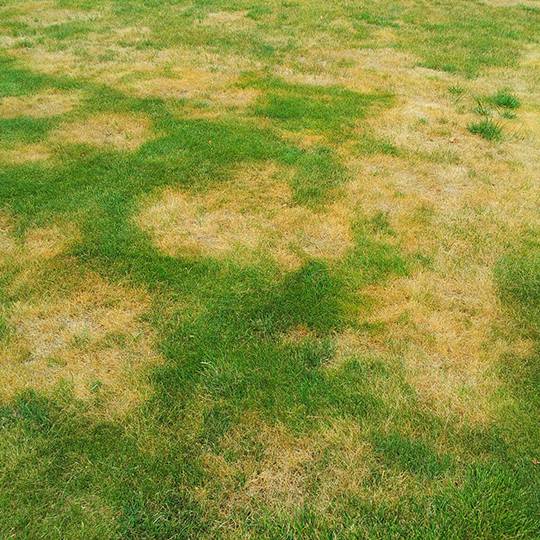
Grasses primarily affected: Kentucky bluegrass, annual bluegrass, fine fescues.
Summer patch (magnaporthe poae), or poa patch, is a lawn disease. This root-destroying fungus is recognizable by the 1” to 2” circular patches of dead grass it causes to appear on the lawns it infects. These patches may grow to form ring- or crescent-shaped patches 3” to 12” in diameter, often with an outer ring that ranges from yellow to bronze in color. Often, if a clump of a resistant grass type is growing there, a “frog eye” pattern forms inside the middle.
The marks are similar in appearance to dollar spot and necrotic ring spot, but summer patch is for worse for your lawn because it kills both the roots as well as the grass. Unfortunately, reseeding is often necessary after a battle with a summer patch infection.
Summer patch thrives in sunny, hot conditions—in temperatures averaging 90 degrees or higher—and generally appears in shorter grass.
Summer patch signs and symptoms
The rings and crescents of summer patch can join together to form more irregularly shaped spots as well as in long streaks. Dead patches are identifiable as summer patch (and not the similar dollar spot or necrotic ring spot) by the roots. Pull up a tuft of grass and examine its roots. The roots of grass infected with summer patch are dark brown or black and short because they are rotting. Healthy grass roots are lighter in color and longer.
It is possible to have summer patch on your lawn and not even realize if your grass is on the longer side. This is because the blades can hide their dying roots. But, because summer patch mostly affects closely mown grasses, this occurrence is relatively uncommon.
Summer Patch Prevention
Prevent summer patch by not cutting more than 2/3 the length of grass when you mow. Taking that much length from grass that has been left to grow long is the cause most associated with the cause of this disease. Known as “scalping,” the practice of mowing too closely weakens the grass and makes it vulnerable to infection.
Avoid adding nitrogen-based fertilizer to your soil in summer. Watering lightly and frequently in hot weather is another practice to avoid as it dampens the shallow areas where magnaporthe poae resides, helping promote its development. Soil aeration is important to prevent thatch buildup and improve drainage.
Because summer patch can cause massive damage in a short time, fungicides are often necessary to combat its spread. Contact the experts at Cardinal Lawns to discuss how they can help you make your lawn look its best.
Need Help with Summer Patch?
Call Cardinal Lawns today at 614-808-4446 and let's talk about how we can help treat for Summer Patch and other common Ohio lawn diseases.
Get a Free Quote